By Ding Xianfeng from GXIC team, nicknamed Kezhen at Alibaba. Ding is a Alibaba Cloud Scientist.

In the age of 5G, the Internet of Things (IoT) will develop rapidly and create a world of Digital Twins. At the same time, the manufacturing industry in China and around the world is also being transformed, with the effect that industrial applications of IoT is becoming a major trend in IoT technologies. But with all of this happening, what cutting edge technologies are emerging in the IoT field? What are our thoughts on advances in the areas of AI and the Internet of Things? What should we think about 5G, IPv6, blockchain, spatiotemporal information, and Digital Twins?
This post is written based on a presentation given by Ding Xianfeng, Alibaba Cloud's chief AIoT (Artificial Intelligence of Things) scientist and artificial perception and cognition expert. In his presentation, Ding answered the above questions and shared some of his insights in this space. Ding Xianfeng has twenty years of experience in the areas of IoT and AI. Recounting Ding's presentation, this post outlines Alibaba Cloud's industrial IoT platform and some of its related technologies from Ding's perspective.
As the chief scientist of the Alibaba Cloud IoT business unit, I am in charge of the construction of the Alibaba Cloud IoT platform and the Industrial Internet platform.
First, in this presentation, I would like to discuss how open sourcing and community support can benefit the "Industrial Internet." Open sourcing technological advancements and online community support and collaboration is a crucial piece to developing and sustaining the large-scale development of the Industrial Internet. But you may wonder, with my saying this, why do we want to build the Industrial Internet? And what exactly is the content of it?
Well, to give a simple answer the Industrial Internet is in essence industry digitalized, realized as part of our worldwide web. The Industrial Internet converges the industrial knowledge that humans have accumulated over a period of well over 200 years on the Internet in the form of software or data. Consider this example, for instance. Digital libraries have digitize many of the world's books. When it comes to books in the industrial space, for example, knowledge and formulas in physics, chemistry, and mathematics and the like have been digitized at an impressive scale. However, these cannot be called directly. Instead, programming is required to apply the knowledge to control machines. In a summary of the past 20 years, the Internet was mostly used for the storage, processing, and transfer of information. But, in the coming 20 years, human all over this plant will further encode our accumulated industrial knowledge in the specific forms of mathematical formulas and simulation models, to provide two examples.
This will make the Industrial Internet a large-scale project. The industrial spaces and sectors of society includes what can be only described as innumerable number of sectors, each of which can be further divided into hundreds of smaller segments. Facing such a large-scale and complex industrial system, you'll probably then think, is there a way to easily reuse our accumulated knowledge, such as the established models? Well, previously and even presently, models and mathematical formulas could be shared over the Internet. But all of this sharing in many ways was severely limited by copying.
However, once Software as a Service (SaaS) became an established model, everyone could easily start to use the model by inputting parameters as needed. Obviously, this sort of change, looking ahead to the future, will greatly increase the utilization rate of human knowledge as well as boost the collaboration levels that humanity can reach, having an effect arguably analogous to the agricultural revolution that occurred 10,000 years ago.
We are not satisfied with merely a digital library of all of literature. Instead, we need a comprehensive code repository of it. There are several ways to deal with the tremendous workload required to meet this goal. For one, we can hire experts from all over the world to contribute code, but this would be a very costly process. Another way is to imitate the patent system. That is, whoever contributes will get the patent. However, this will discourage people from contributing the models of several expired patents, among other things.
I think that knowledge and models should be commonly owned and accessible by all humans, that is be made open to the public, open source, rather than by a small group of people or companies. Those who write code should be paid, but their knowledge and their models should be accessible by the public and free of charge. Such a large-scale knowledge digitization project would be a great stride in the development of the labor force, so it would be rather fascinating if a great number of people could participate in such an effort.
Since a wealth of knowledge and models should be shared with everyone, we must make them open-source. Doing so means sharing them with everyone, with the world. Only the open-source model can allow everyone to participate and contribute. Only in this way can we collect the industrial knowledge of the last 200 years to the most comprehensive and all-encompassing fashion. Of course, new innovations and all sorts of inventions keep emerging. These required much effort, and therefore, I think, companies can still keep their new inventions not open-source, and grant the rights of use for a fee.
Next, let's discuss the differences between the Industrial Internet and the IoT. IoT is now a relatively commonly known term. The Industrial Internet isn't though. In a nutshell, the Industrial Internet works by using the IoT to connect users and machines, as well as various materials, methods, and links after they have been digitized and become part of the Internet. The Industrial Internet works so that the entire industry production processes can be streamlined and optimized based on these resources, so that the demand of mass customization can be responded to in a faster and more agile way.
The Internet as we know is a pronominally consumer-oriented Internet, being dominated for the past 20 years by individual consumers. Among other things, through the development of e-commerce, food deliveries, and even ride share services, this Internet landscape has brought commodities closer to consumers. However, in the coming 20 years, I reckon, the Internet will be dominated by the industrial applications, which in many ways will be a redefinition of industry, Industry 4.0, if you will. It will pick up the baton from the consumer-oriented Internet and bring manufacturing systems closer to consumers. In the age of the consumer-oriented Internet, production plans were put first and consumers had no chance to define product demands. They had to wait before products were available. By contrast, the Industrial Internet will involve consumers in the manufacturing process. This will enable the entire manufacturing system to quickly and agilely respond to personalized needs of consumers.
Technology is a driving force in every age. For instance, Newton's three laws gave birth to Watt's steam engine, which further led to mechanization. Maxwell's equations laid the foundation for Edison's generator and the light bulb, which further led to electrification. Semiconductors brought us to the world of electron tubes, transistors, and then integrated circuits that is vigorously driving development in the age of information.
Similarly, the Mobile Internet has been driven by powerful technologies over the past 10 years. What is driving smart phones? 4G technology. Only when the chip technology had matured to a certain level could it support us to make smart phones and spur development in the age of Mobile Internet. But, what will be the next age? And what technology and industry will dominate it?
Now, let's talk more about the age of 5G, or the age IoT. What is the technological driving force of this age? The 4G technologies enabled the exchange of information between 10 billion users. Now the IoT together with 5G technologies will enable information to be exchanged between nearly one trillion things. The demands of interpersonal information exchange were well addressed in the age of 4G. 5G, IPv6, and related technologies will exchange information between things.
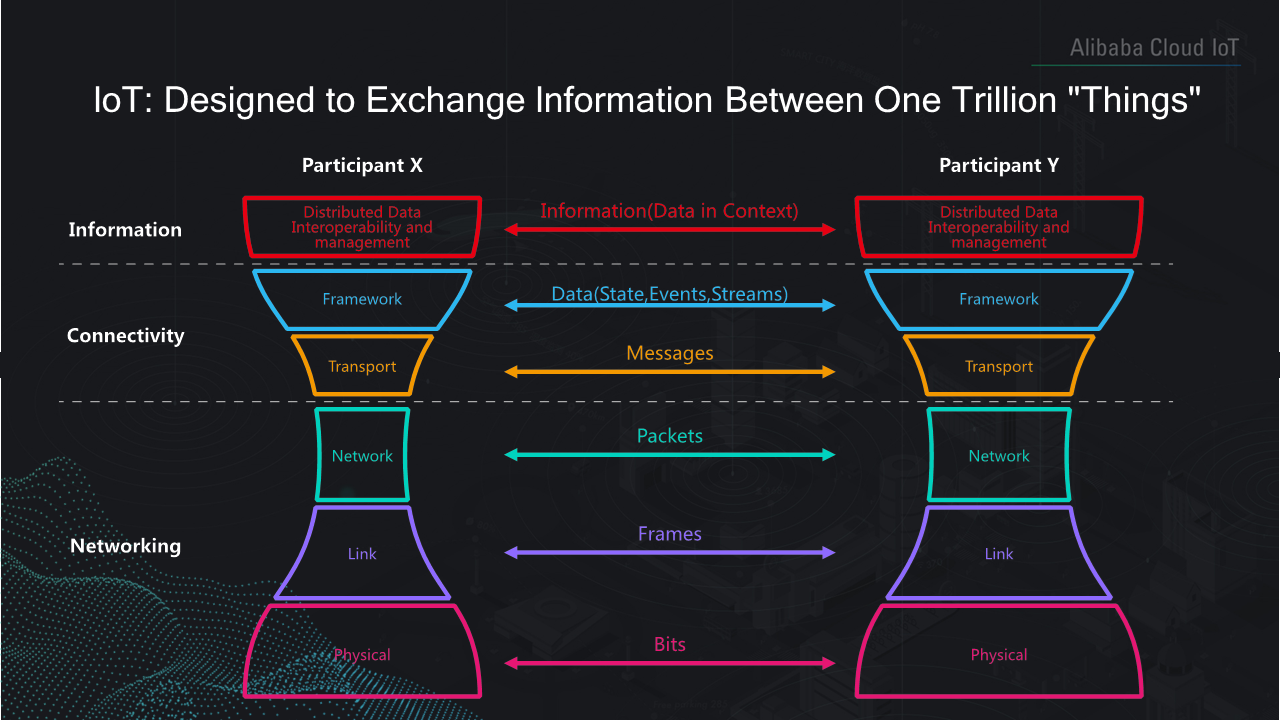
From bits to frames and from packets to messages—in the future there will be participant X and participant Y. Human participants on the Internet may account for only 10 billion out of one trillion, with the rest being things. You may be exchanging information with your light bulb or your car, or your car may even exchange information with your light bulb. The coming age will be driven forward by IoT technologies.
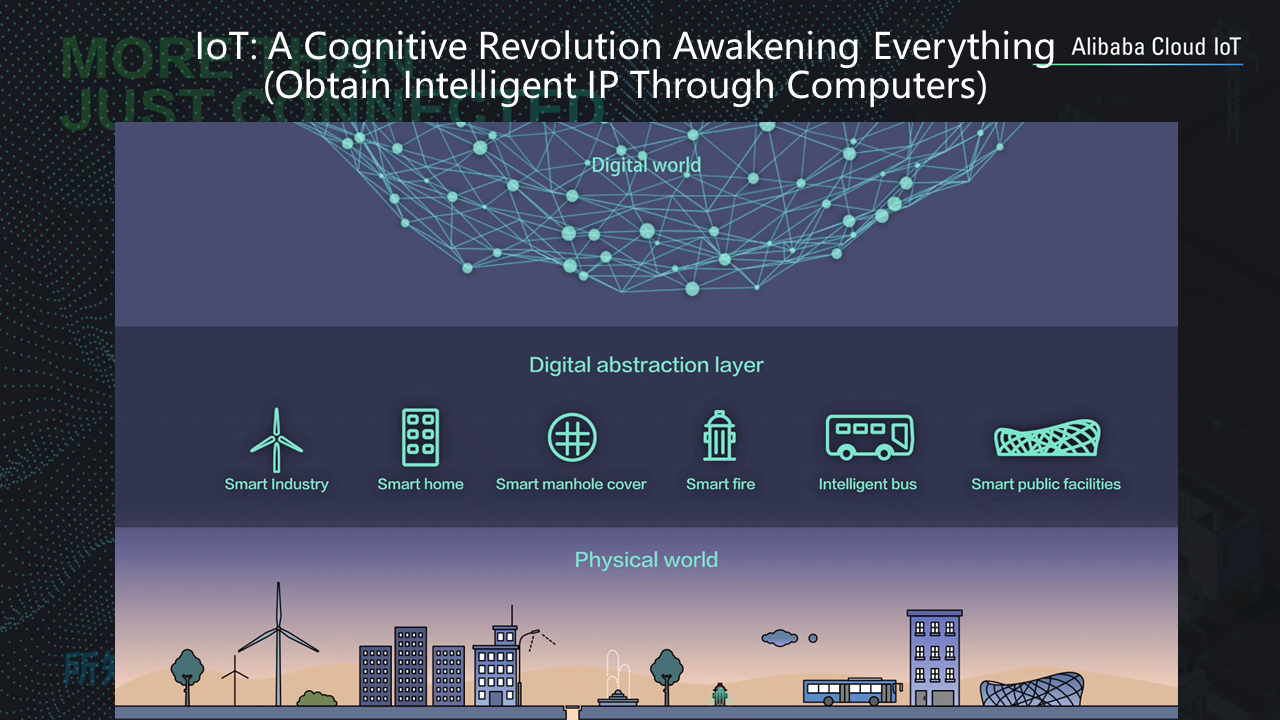
Once the Internet of Everything is established, we will need to build a digital abstraction layer to map every object from the physical world to the digital world. In the digital world, computers can give full play to their powerful computing capabilities to process big data, small data, and time series data. This will once again greatly improve the efficiency of all aspects of human life.
It is predicted that technologies such as the IoT, AI, and 5G will generate a value totaling some 11 trillion US dollars for human society by 2025 or 2030. The manufacturing industry is expected to have the greatest share, accounting for anywhere from 1.2 trillion to 3.7 trillion US dollars. Manufacturing itself is the second largest industry in the world, accounting for approximately 40% of China's GDP. So, even an influence rate of 1% will generate a profit of hundreds of billions of Chinese yuan. Multiplied by the valuation, it will make a valuation difference of several trillion yuan.
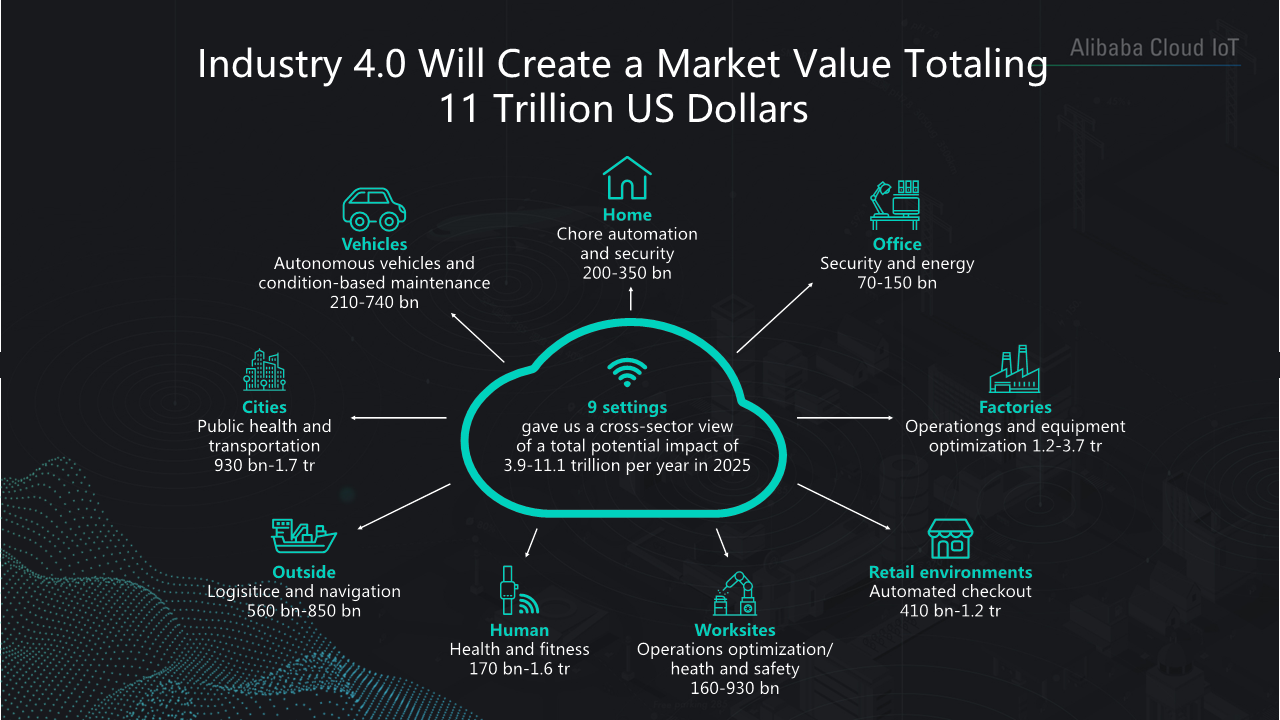
Based on the general trends we discussed, next I would like to introduce several of the most important technologies related to IoT. I am going to talk about why these technologies were created for IoT rather than how they were created.
The first and most important technology is, I think, 5G. It is not merely an extension of 4G. Actually, there is only one extension of 4G, Enhanced Mobile Broadband (eMBB). eMBB does nothing more than enhancing video calls to 3D ones. Massive machine type communications (mMTC) and ultra-reliable and low latency communications (URLLC) of 5G have been designed to address the needs of IoT devices.
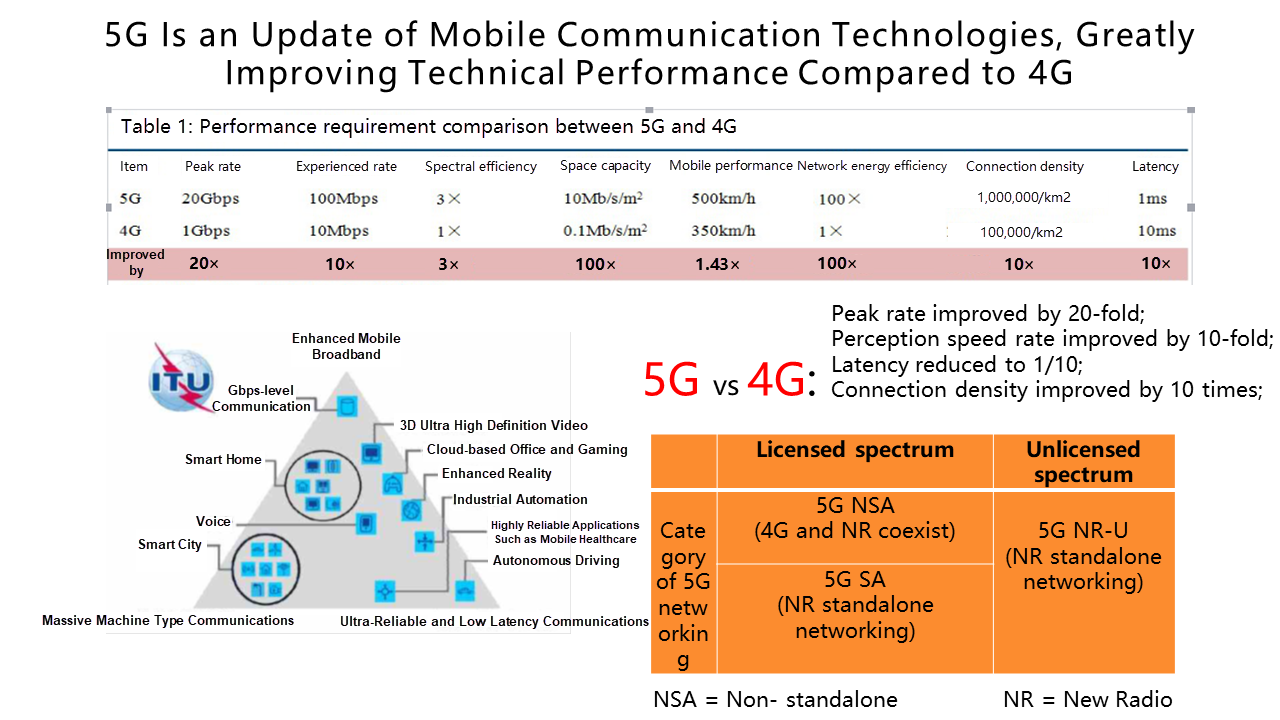
5G provides three key features: eMBB, mMTC, and URLLC. eMBB was designed for high-definition videos and human-machine interaction in AR and VR applications. mMTC was developed to connect low-power or ultra-low-power devices, such as household water, power and gas supply meters. These meters are densely distributed, so it is necessary to divide the communication into many high-density channels and keep the communication at ultra-low cost and power consumption. URLLC was developed for high-precision industrial control and autonomous driving applications. For example, URLLC can address the needs of a running mechanical arm or a running autonomous vehicle that is highly sensitive to latency and requires ultra reliable transmission.
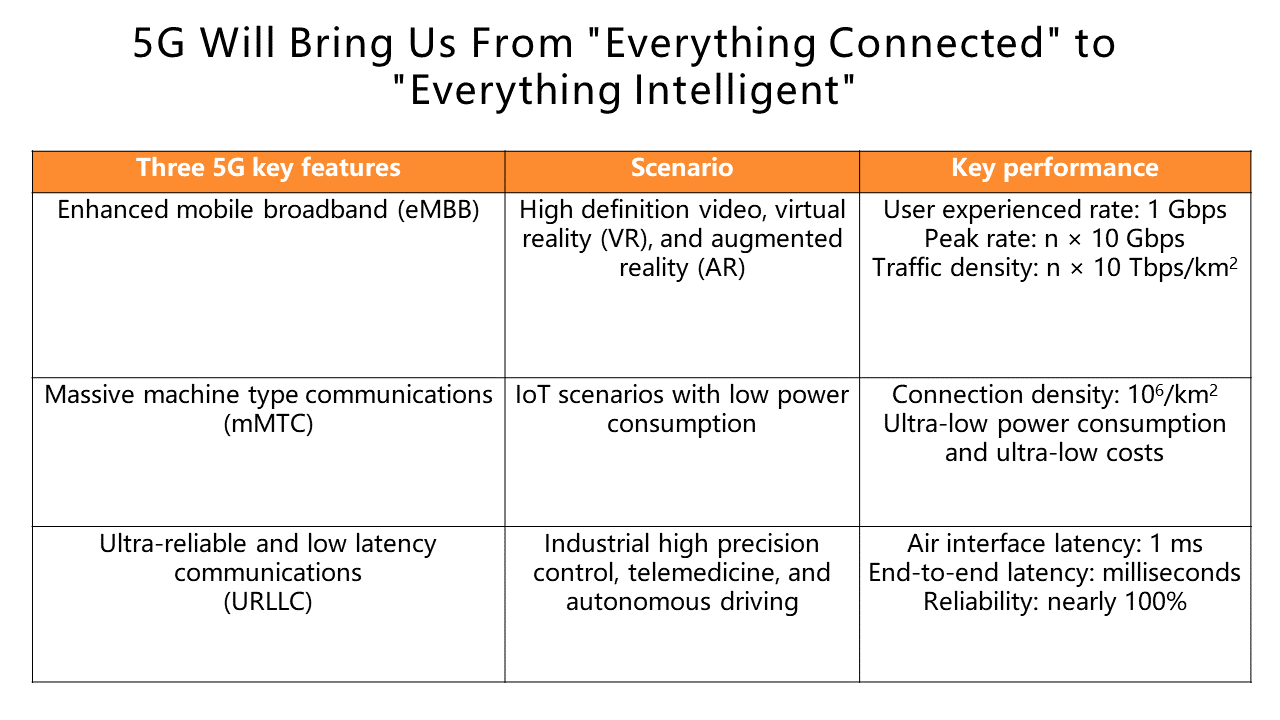
Since 5G is designed for the IoT, it no longer needs a very broad bandwidth for mobile communication. Therefore, private networks will play a key role in the future, and so will low-cost cloud-based core networks. In this respect, Alibaba is investing heavily in cloud-based 5G core networks and mobile edge computing (MEC), and has added 5G protocol stacks to terminals in order to empower customers to develop smart homes, smart campuses, smart cities, and smart industry.
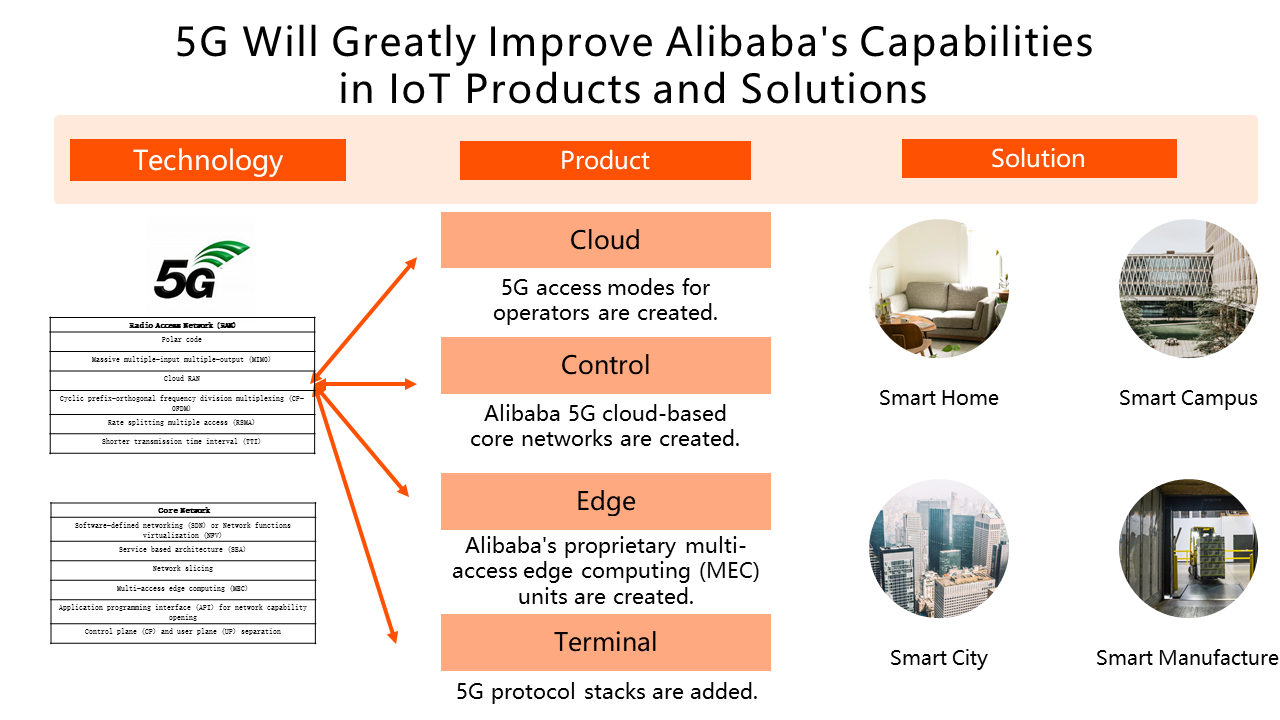
Then, why was IPv6 developed? IPv6 revolutionizes network topology. It enables IoT devices to communicate freely with each other without relays or P2P traversal. With IPv6, devices become first-class participants in the network world rather than having to hide behind gateways. Additionally, IPv6 networks allow direct IP access, reducing the network latency by 10-30%.
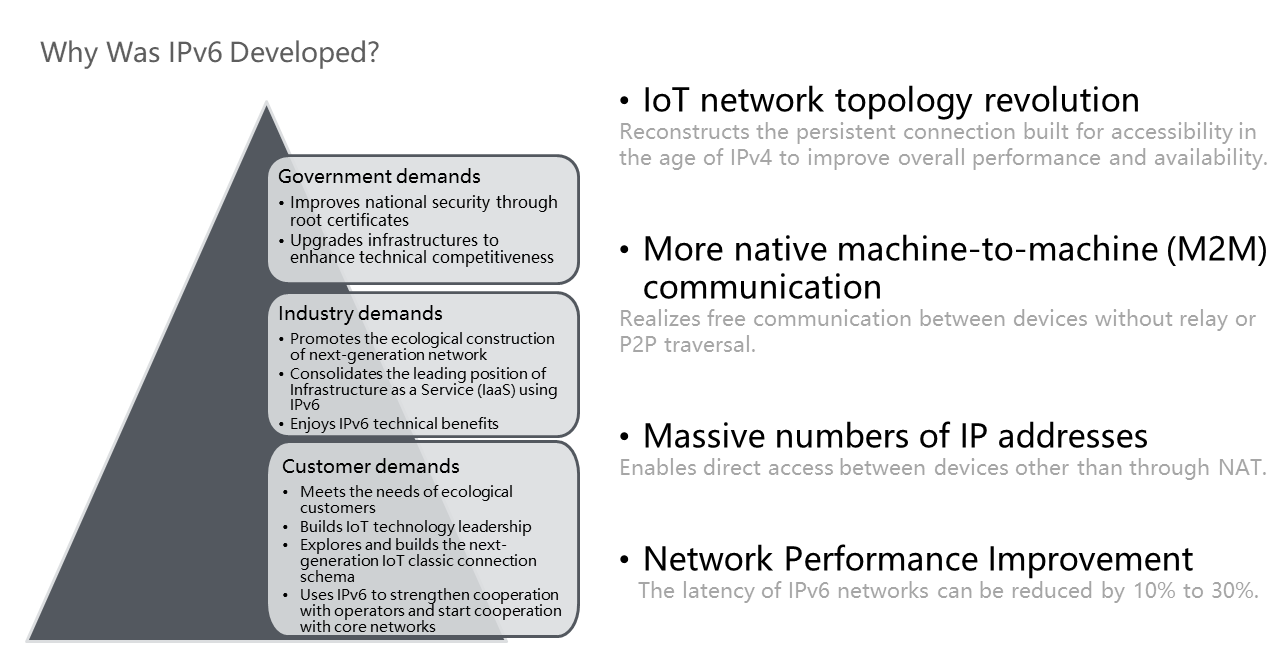
In short, 5G increases channel capacity and IPv6 implements direct IP access, packing the physical world into a flat network. Alibaba works with its partners to provide a variety of IPv6 technologies. IPv6 connectivity is right at your fingertips, whether you are accessing through LoRa base stations, edge gateways, private clouds, WiFi, or Bluetooth.
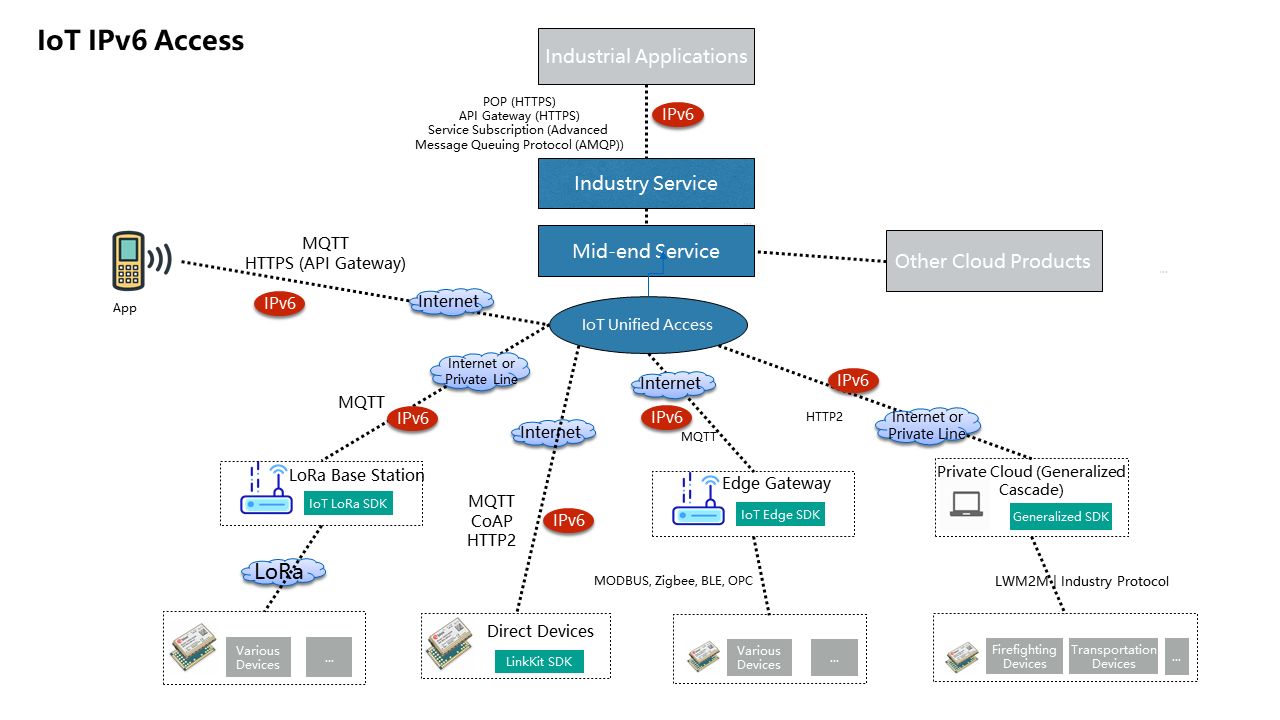
We also provide IPv6 access on Alibaba Cloud, private clouds, and our Apsara Stack all over the world. Currently we provide IPv6 access. In the near future, we will provide IPv6 topologies. In the long run, we will provide IPv6 Machine to Machine (M2M) capabilities to customers.
Positioning technologies also play an important role in the age of IoT. In this age, everything must have a spatiotemporal index. Accurate location is required for everything like airplanes, vehicles, mobile phones, and IoT devices, whether moving or not. Therefore, the positioning technologies in the age of IoT must be superior to those of the age of the Mobile Internet in terms of accuracy, power consumption, and coverage. Indoor and outdoor positioning relies on a variety of wireless technologies, sensing technologies, and advanced fused algorithms.
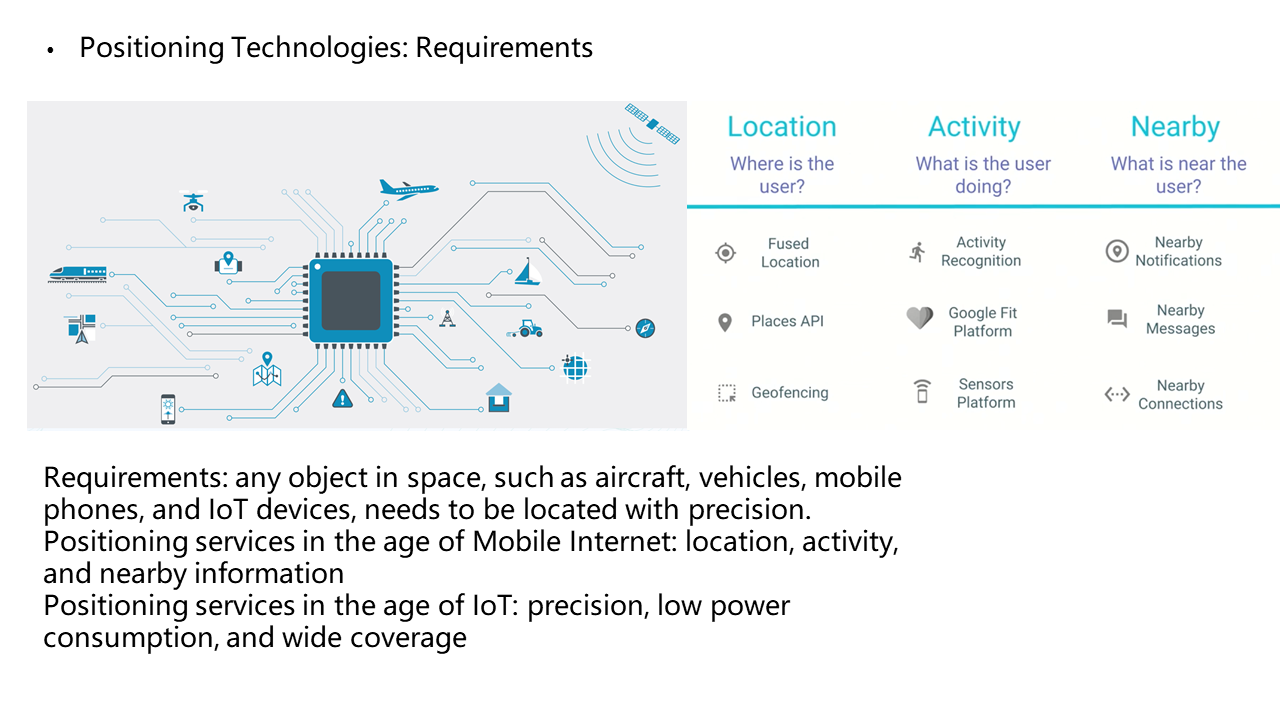
Mobile phone positioning technologies can be divided into the following categories. The first is represented by the global navigation satellite system (GNSS), which includes Global Position System (GPS), Beidou ("Big Dipper") Navigation Satellite System (BDS) or Galileo Satellite Navigation System (GSNS). It also involves a variety of filtering algorithms and fused algorithms in addition to some network-assisted positioning technologies. The second is network positioning technologies such as global IP positioning, global base station positioning, global WiFi positioning, reverse geocoding services, and motion status detection. This category also includes some offline positioning services. Another category is sensor-assisted positioning such as Pedestrian Dead Reckoning (PDR) and Vehicle Dead Reckoning (VDR). The PDR or VDR can continue to reckon the track of a person or vehicle even without GPS or a network. The last category is map matching (MM) navigation. MM can be done both on the cloud and on the terminal. For example, when a track obviously matches a certain road on the map, the positioning drift can be corrected.
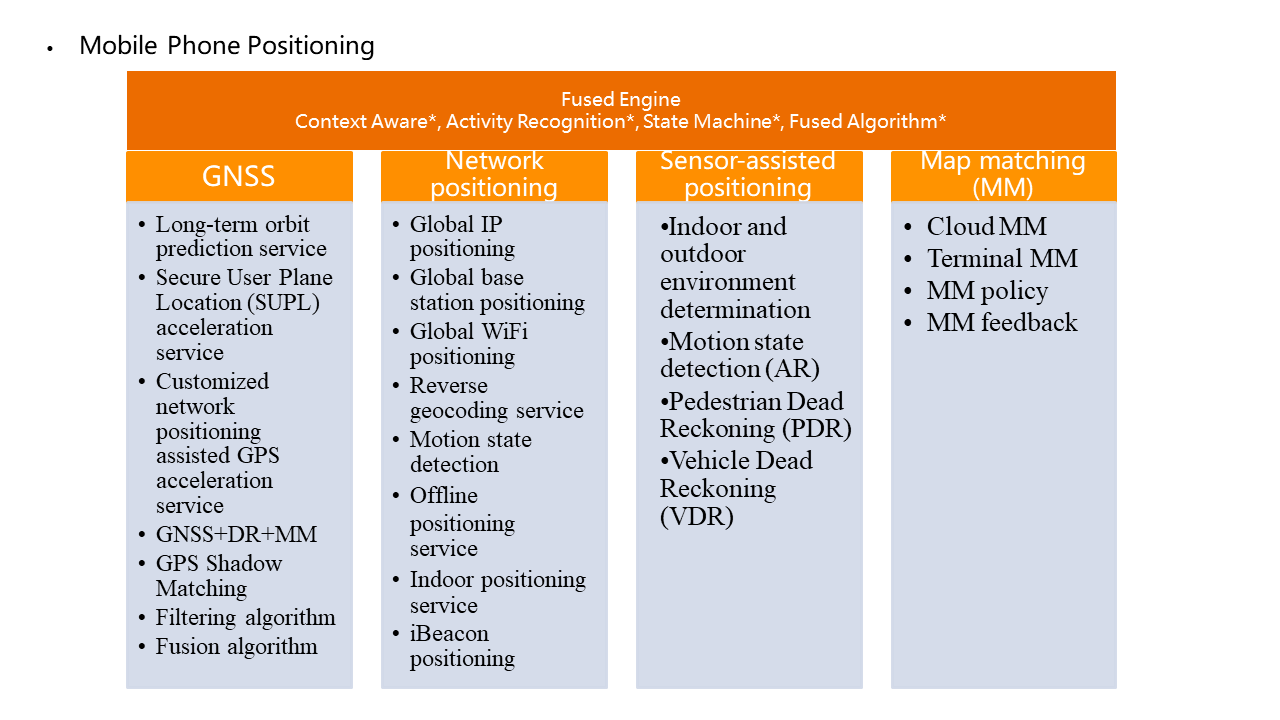
Similarly, vehicle-mounted positioning technologies are classified into several types, including virtual input/output (VIO), simultaneous localization and mapping (SLAM), semantic positioning, multi-sensor fusion, and high-precision map technologies. Vehicle-mounted positioning and navigation technologies can be developed on the basis of mobile phone positioning technologies. Future vehicle-mounted positioning will definitely require more accurate coverage, smaller coverage areas, and more information features compared with mobile phone positioning.
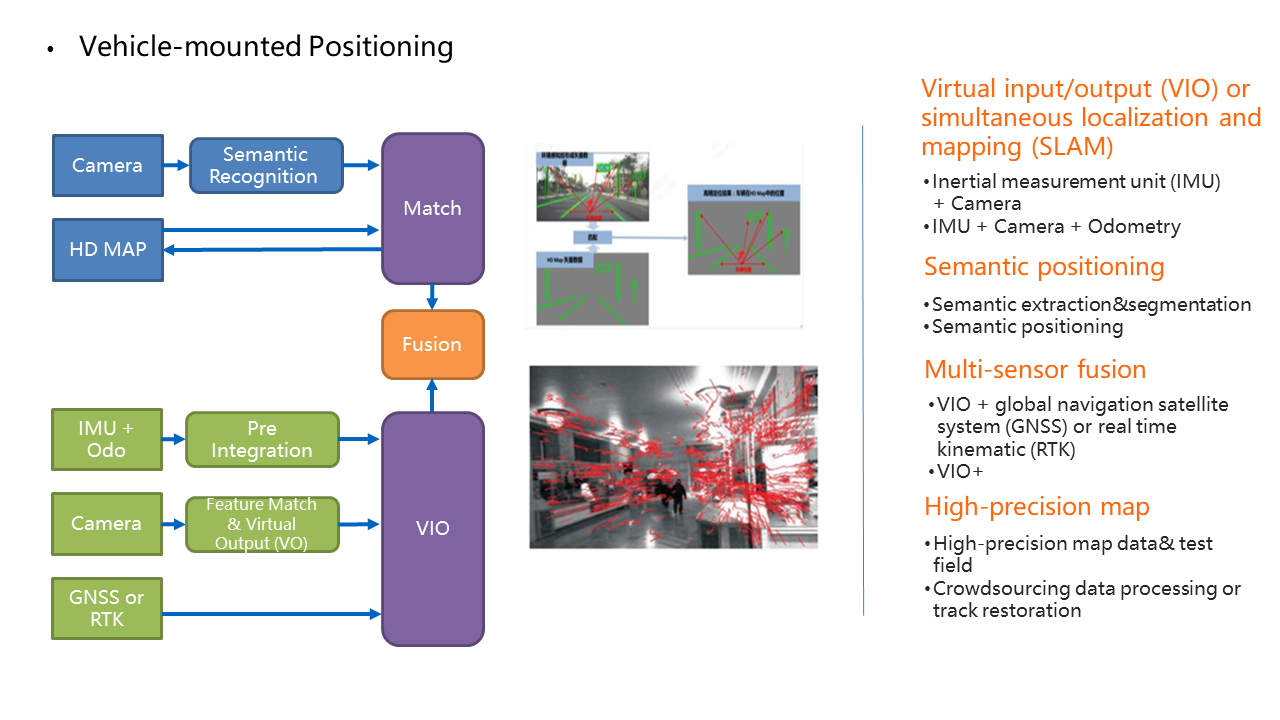
Positioning technologies and data technologies will form a variety of closed data loops. Cross calibration between positioning technologies and data services will make the entire IoT increasingly accurate. For example, city or region map data and positioning technologies will be cross calibrated. In this way, errors caused by GPS drift can be corrected using a large amount of crowdsourcing data.
Now, I would like to briefly talk about the Geographic Information System (GIS) technology, which is used with the outdoor positioning technologies. GIS is software that combines various information such as map information, road information, and high-level information. GIS has several major components, including data collection, management, analysis, and application.
It has developed into a mature stage over decades. GIS and IoT will be combined in a way that IoT provides realtime data and GIS provides data collection and analysis engine capabilities. These capabilities will help IoT applications implement better processing and display. For example, in the management of a smart city, IoT provides massive amounts of dynamic data, such as data on people, vehicles, things, weather, and numerous types of video data, and GIS provides a large amount of spatiotemporal benchmark data. A variety of commercial applications can be implemented, covering urban rain and flooding, pollution diffusion, comprehensive pipe network, and urban settlement.
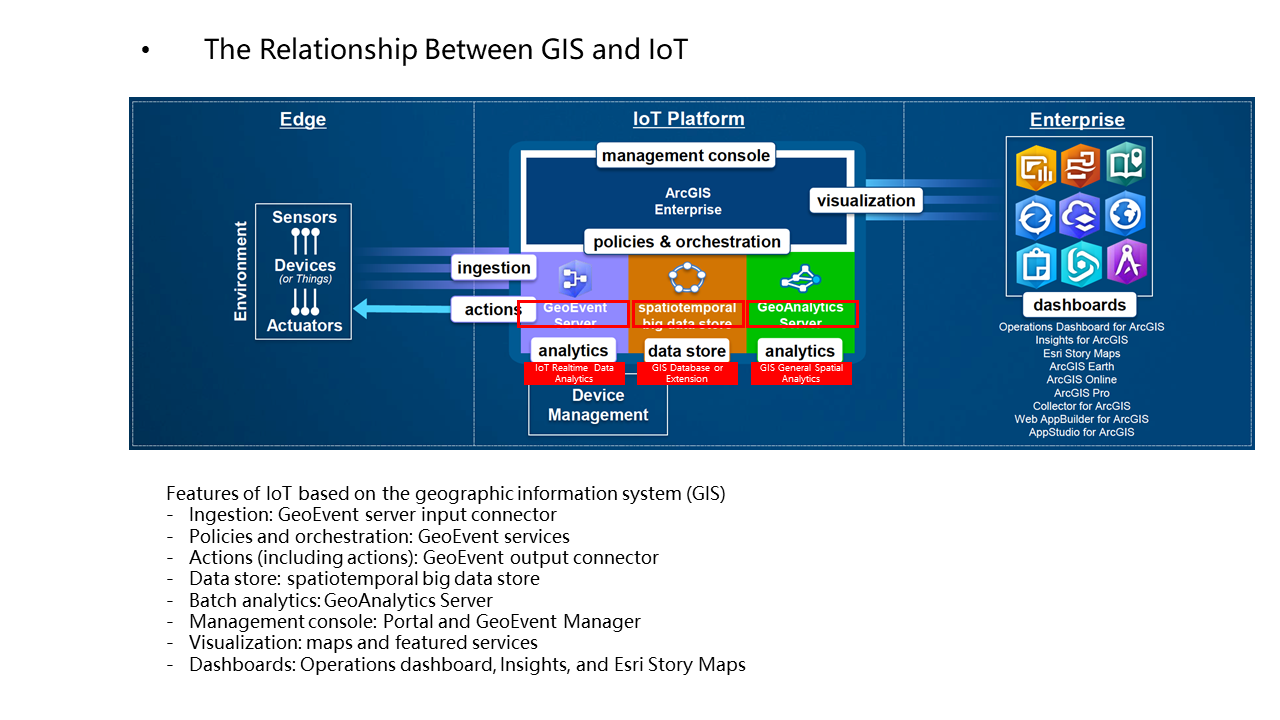
Indoor positioning technologies are very important to the Internet of Things. Several common indoor positioning technologies include WiFi, Bluetooth, ZiBee triangulation, and geomagnetic positioning.
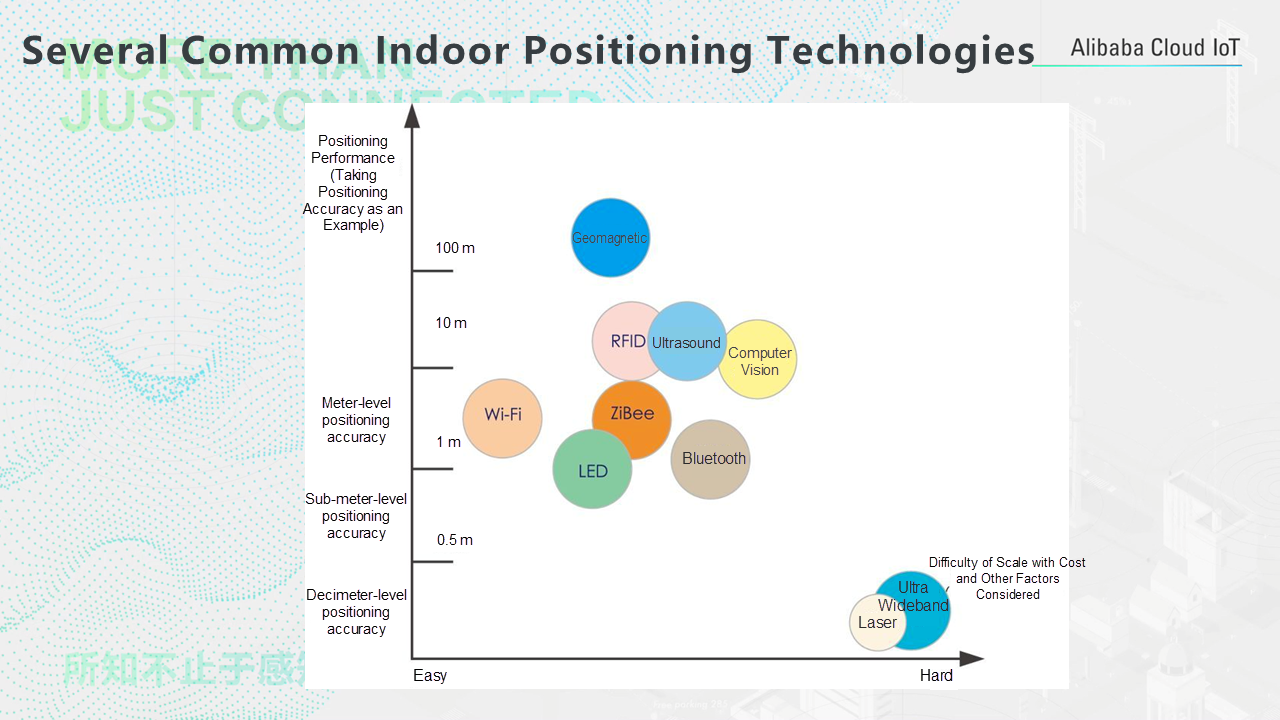
Most positioning technologies are based on multilateral positioning, including WiFi, Bluetooth received signal strength indication (RSSI), ultrasound, ultrawide band (UWB), and ZiBee. Now there are the new Bluetooth 5.2 angle of arrival (AOA) and radio frequency identification devices (RFID) technologies, which can support more accurate indoor positioning.
There are some other positioning technologies, including fingerprint positioning, indoor inertial navigation positioning, and 3D visual imaging positioning, such as indoor robot laser radar, millimeter wave, and ultrasound. These positioning technologies will be applied in manufacturing systems covering automatic loading, storage and transportation, and logistics and feeding. These are all important basic technologies for Industry 4.0. There is no doubt that various sensors or technologies will be combined for the positioning of indoor robots and other objects. Indoor positioning will become an essential product of Industry 4.0.
Indoor positioning in most cases involves an indoor 3D coordinate system. This system uses the Building Information Modeling (BIM) and a database to show various 3D data of a building, such as data about passages and walls. This is similar to how GIS shows outdoor geographic information.
With GIS information, IoT information and positioning information, realtime device data can be input into the BIM system using the IoT data platform, indoor positioning technologies, and indoor spatiotemporal technologies, allowing personnel, events and other information can be mapped to the digital world. This enables data analysis to cope with various scenario-specific demands, such as making an emergency fire evacuation plan, analyzing shopper behavior, getting a customer flow heatmap, or even recognizing the need for air-con settings in real time.
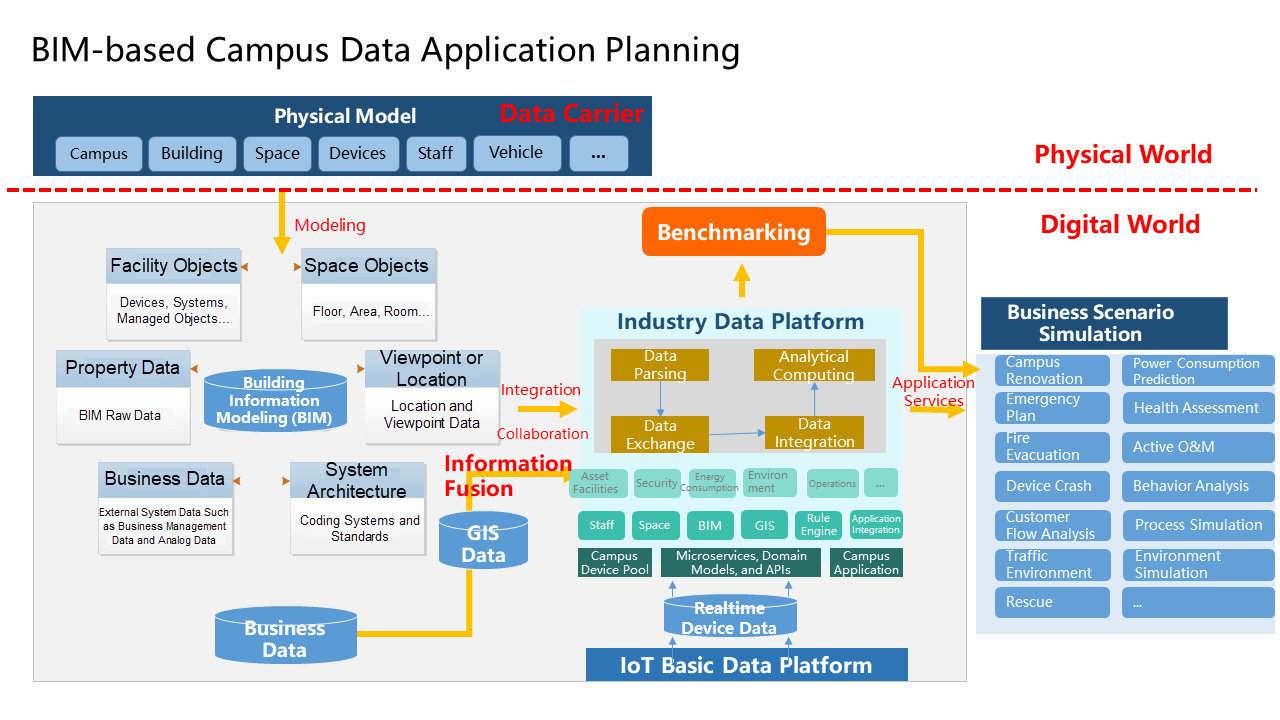
In other words, indoor positioning can provide a spatiotemporal reference for mapping the physical world to the digital world, and the BIM system can analyze and display the mapped data, enabling a better IoT application. The technologies mentioned address different demands respectively, allowing us to accurately describe a digital world.
Now let's take a brief look at blockchain. First let's cover what blockchain actually is. Consider this. When you buy a house, you need a ledger to record the transaction and contract terms. You need a highly credible third party to input the bank loan, the broker's commission, and your payment into the ledger to create the transaction. However, the ledger holder can tamper with it.
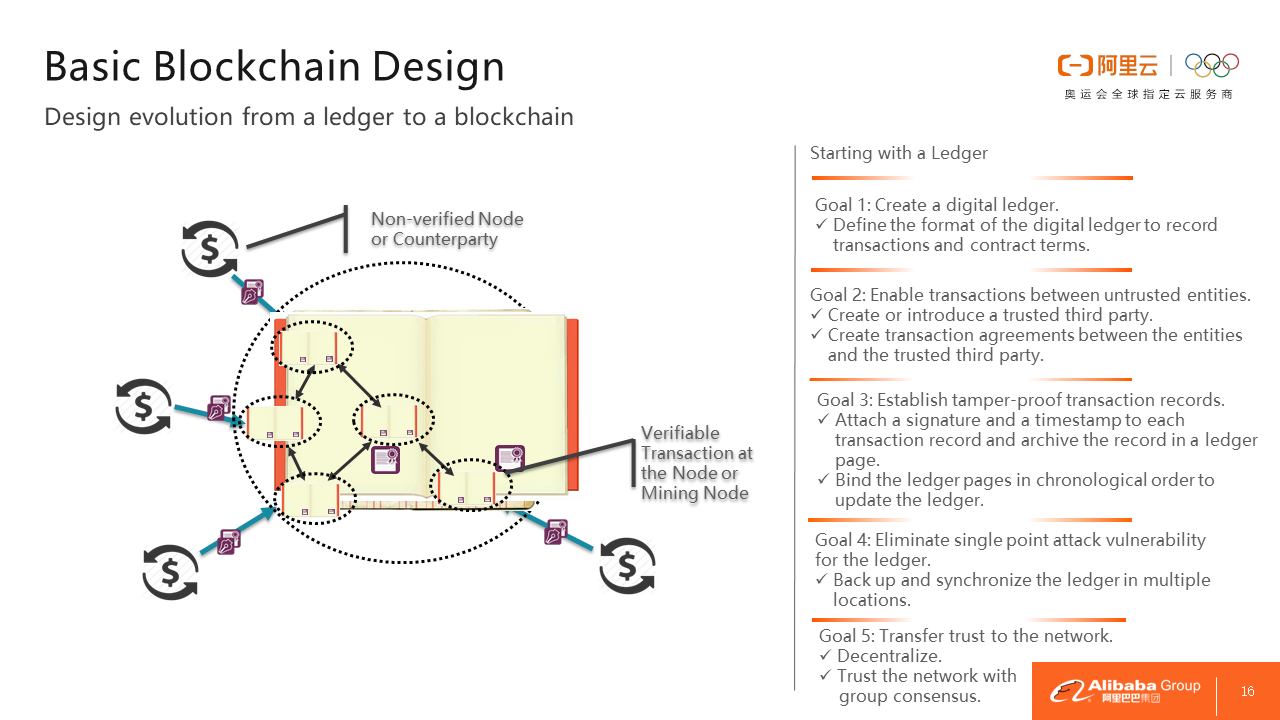
What can you do to make the ledger tamper-proof? First, you need to add a signature and timestamp to each record in the ledger. If people attempt to change a record, they have to change all the previous ones. Therefore, when a ledger has hundreds of transaction records, tampering with one record would be very difficult.
Second, you need to create multiple backups. Each participant in the transaction keeps a copy of the ledger in the IoT. That is, each participant has an edge computing node. If people want to tamper with the ledger, they have to change all the backups, which is very difficult. In other words, the risk of trust is decentralized across the network and trust is built through a group consensus mechanism.
Such a mechanism is inherent to the IoT. Basically every house has a router and an edge computing node, and every cell has an edge server. Each of them can be regarded as a ledger for data transactions. For example, if someone used a lamp in your house, how many times he used it and how much power it consumed were recorded. These data points are undeniable.
Based on Ant Financial's Ant blockchain, Alibaba Cloud has developed a technology stack for IoT, including the data layer, network layer, consensus layer, contract layer, access control layer, and application layer. We use the distributed ledger network of edge IoT consortium blockchain to collect data and put it in the microservice cluster for edge IoT consortium blockchain management to support a variety of blockchain IoT applications. For example, we can support data consumers in data exchange in the areas of logistics, warehousing, finance, insurance, and the like.
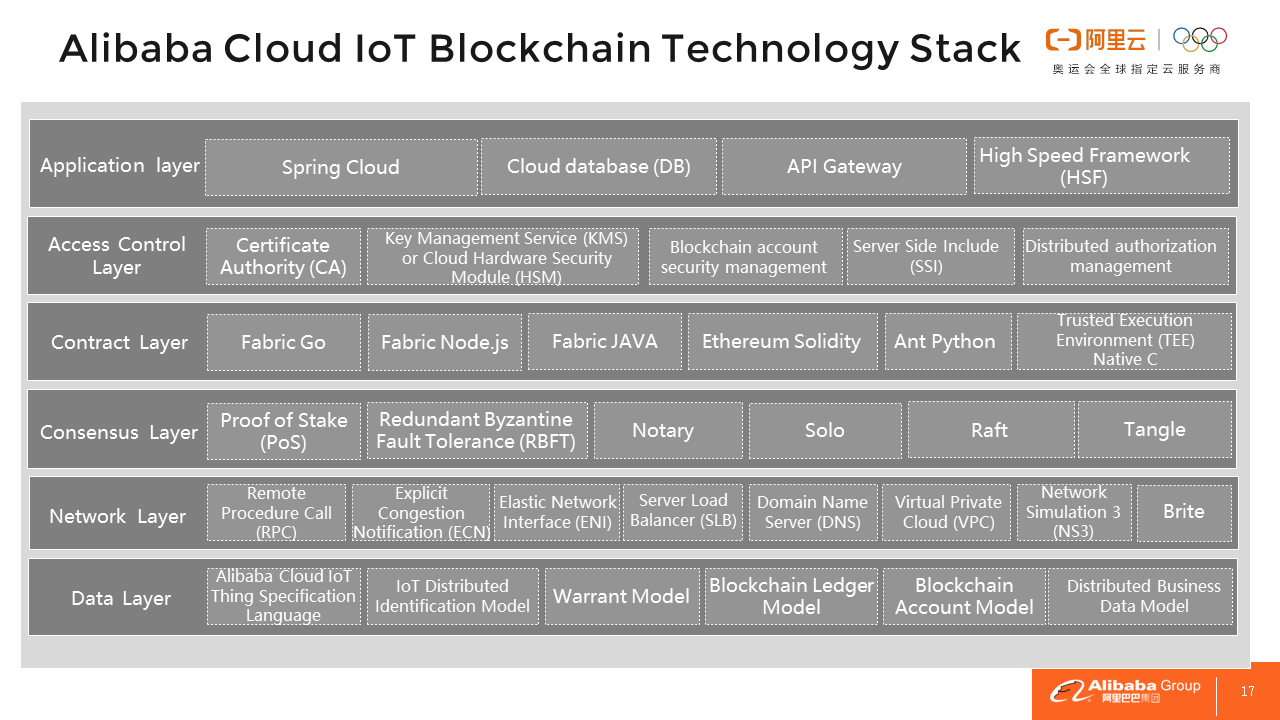
Another important part of the Industrial Internet is the Digital Twin, which can enable better human-machine interaction. The Digital Twin can be widely applied to, for example, visual maintenance, device status visualization, remote interaction, and 3D device operation guides. For example, the collected data of a water pump can be delivered to you in real time so that you can see what is going on inside the pump. In addition, other people can remotely help you identify problems. This allows field O&M personnel to work more efficiently.
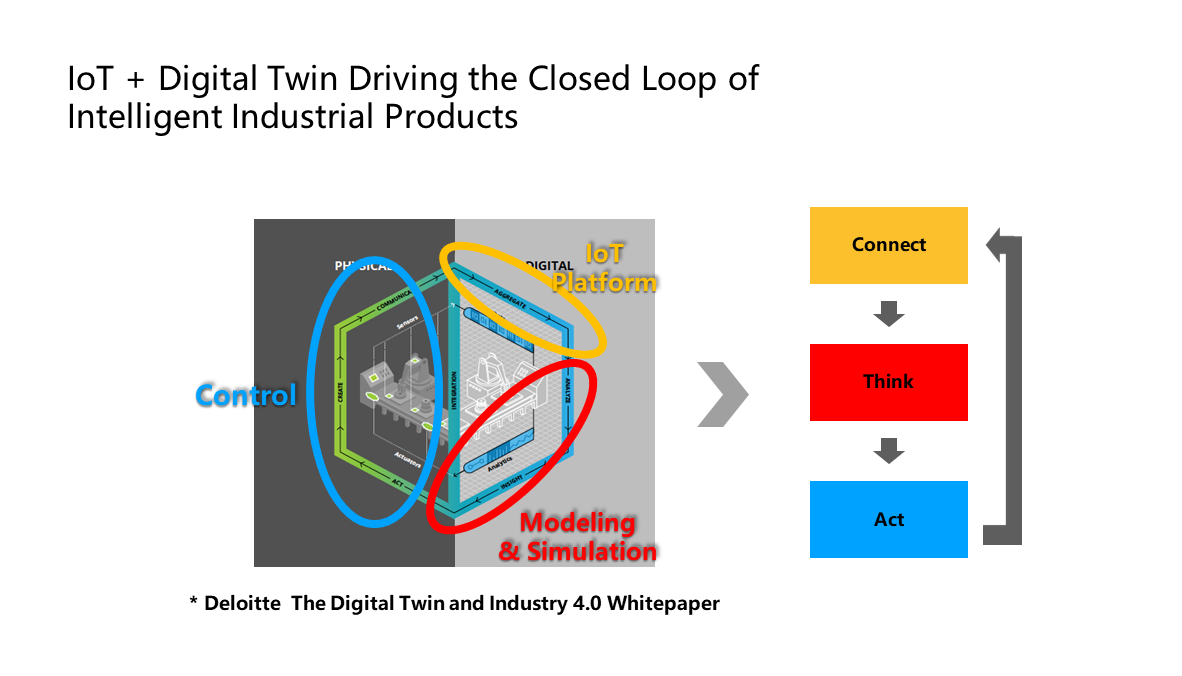
The age of 4G is about the Mobile Internet, focusing on mobile, social, and local applications. Then, what is the most valuable application in the age of IoT? I believe it is the Industrial Internet. 5G can increase channel capacity, IPv6 can implement direct IP access, indoor and outdoor positioning can provide spatiotemporal benchmarks, and blockchain can solve the issues of data protection and trust. Combined with the Digital Twin, all these technologies build digital entities in the digital world. In the light of these technologies, I think industrial manufacturing technology will be the most influential trend in the future.
Get to know our core technologies and latest product updates from Alibaba's top senior experts on our Tech Show series
See How a Professional Translation Platform's Helping Experts Fight the Coronavirus

2,593 posts | 791 followers
FollowNick Patrocky - August 5, 2022
Alibaba Clouder - April 13, 2018
Lady Amelia - September 19, 2024
Alibaba Clouder - March 5, 2018
Kalpesh Parmar - January 6, 2026
Alibaba Clouder - November 19, 2018

2,593 posts | 791 followers
Follow Platform For AI
Platform For AI
A platform that provides enterprise-level data modeling services based on machine learning algorithms to quickly meet your needs for data-driven operations.
Learn More MaxCompute
MaxCompute
Conduct large-scale data warehousing with MaxCompute
Learn More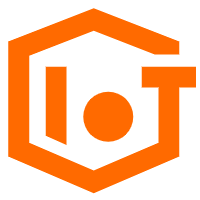 IoT Platform
IoT Platform
Provides secure and reliable communication between devices and the IoT Platform which allows you to manage a large number of devices on a single IoT Platform.
Learn MoreMore Posts by Alibaba Clouder